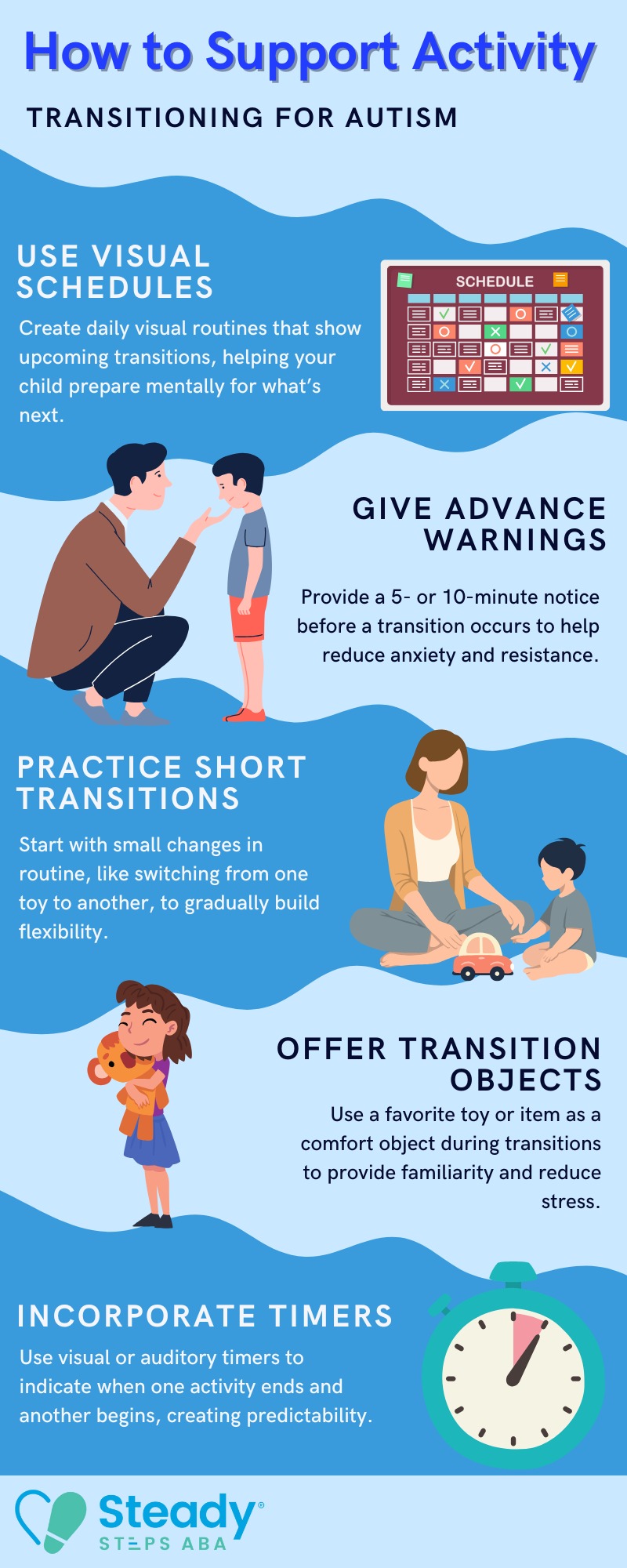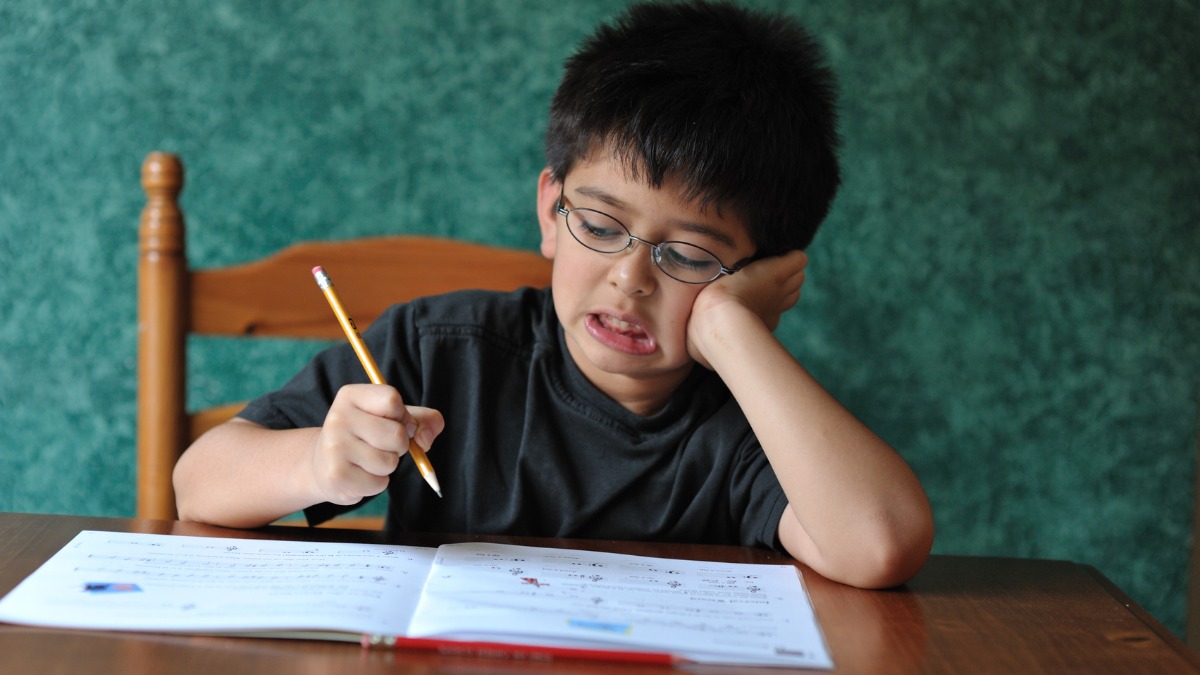Key Points:
- Transitioning between activities can be challenging for autistic individuals due to changes in routine and sensory demands.
- Strategies like visual schedules, countdowns, and consistent routines support smoother transitions.
- ABA therapy can reinforce these techniques across home, school, and community environments.
Sudden shifts from one task to another—whether it’s stopping playtime to start homework or moving from home to school—can trigger frustration, anxiety, or even meltdowns in autistic individuals. This is especially important, considering that approximately 40% of children with autism face challenges with emotional regulation.
Understanding the underlying reasons behind difficulty in transitioning between activities is crucial for families, educators, and caregivers. With the right strategies in place, transitions can become more predictable, manageable, and less emotionally charged.
What Helps with Transitioning Between Activities for Autistic Individuals?
Predictability, structure, and clear communication are the keys to supporting autistic individuals through activity transitions. Whether using visual aids or incorporating sensory tools, proactive supports reduce the stress that often comes with changing from one activity to another. These supports should be tailored to each child’s needs and developmental level.
Transitioning smoothly is often about preparation, both cognitive and emotional. If a child knows what to expect and has consistent cues, the process becomes easier. Teaching and reinforcing these strategies early builds resilience and adaptability.
Why are Transitions Difficult for Autistic Individuals?
Many autistic individuals rely on routine and predictability to navigate daily life. Transitions represent a break in that rhythm. These shifts can cause discomfort, especially when the next activity is unfamiliar or less preferred. Sensory overload or challenges with processing verbal instructions may also contribute.
Another factor is difficulty with executive functioning, such as time management, task shifting, and emotional regulation. For some children, it’s not just the change itself, but the speed at which it happens that’s overwhelming.
Understanding the “why” behind transition difficulties helps caregivers respond with empathy and proactive support.
What are Signs of Transition Struggles?
Identifying the signs of transition-related stress can help caregivers step in before a full meltdown occurs. Some signs are overt, while others are more subtle. Awareness leads to more timely interventions.
Common indicators include:
- Verbal refusal or repeated “No” when prompted to switch tasks
- Physical resistance, like running away or hiding
- Increased stimming (e.g., flapping, rocking)
- Emotional outbursts or meltdowns
- Freezing or becoming nonverbal during transitions
- Anxiety or visible distress before a routine change
By recognizing these signs, caregivers can introduce transition strategies proactively rather than reactively.
7 Effective Activity Transitioning Strategies
There’s no one-size-fits-all solution, but combining multiple techniques can ease the process. Strategies should be consistent yet flexible, evolving as the child grows and gains new skills. Below are some common transitioning strategies:
1. Use Visual Schedules
Visual schedules offer a clear, concrete view of what’s happening next. They help reduce anxiety by showing the day’s flow in a way that’s easy to understand.
Tips for using visual schedules include:
- Use pictures, icons, or real photographs depending on the child’s comprehension level.
- Introduce the schedule at the start of the day and review it frequently.
- Include both preferred and non-preferred activities to balance expectations.
- Allow the child to interact with the schedule (e.g., move icons, check off tasks).
2. Incorporate Timers and Countdowns
Time warnings prepare children for upcoming transitions. These cues give them a sense of control and help them adjust gradually.
Practical timer strategies include:
- Use visual timers like sand timers or countdown clocks.
- Provide multiple warnings (e.g., “5 more minutes,” “2 more minutes”).
- Pair verbal countdowns with a consistent visual or auditory cue.
- Use digital timers on tablets or smart devices if preferred.
The goal is to build awareness of time passing, which supports smoother disengagement from current tasks.
3. Implement Transition Songs or Chants
For younger children or those who respond well to music, songs act as predictable cues. When consistently used, these become meaningful signals that it’s time to switch activities.
Ways to integrate music include:
- Create custom songs for different transitions (e.g., cleanup, bedtime).
- Keep lyrics short and repetitive for easier recall.
- Pair the song with physical movement (e.g., clapping or dancing) to ease the transition.
- Use the same melody daily for specific transitions.
Auditory cues support those who struggle with processing verbal prompts or visual information.

4. Practice Transition Routines
Routine builds comfort. The more familiar the process, the less stressful it becomes. Practicing transitions—even during play or free time—reinforces expectations.
Tips for developing routines include:
- Create a consistent order for morning or bedtime transitions.
- Use the same steps each time (e.g., close tablet → clean up toys → walk to sink).
- Practice “mock transitions” to less-preferred tasks as part of play.
- Reinforce routines with positive feedback or token systems.
5. Offer Choices During Transitions
When possible, give children a sense of autonomy. Choosing how a transition happens can reduce resistance and increase cooperation. Even small choices create a sense of ownership and control, which minimizes power struggles.
Examples of offering choices include:
- “Do you want to walk or hop to the bathroom?”
- “Should we clean up blocks first or puzzles first?”
- “Would you like to use the timer or have me count down?”
6. Use First/Then Language
First/Then statements simplify expectations and set clear contingencies. They help shift focus and attention from the less-preferred task to the reward or preferred activity that follows. This approach works well for children who benefit from structure and straightforward communication.
How to use First/Then:
- “First math, then playground.”
- “First, wash hands, then snack.”
- Use visuals to pair with each step for added clarity.
7. Reinforce Positive Transitions
Reinforcement is key to teaching and maintaining new skills. Acknowledging and rewarding successful transitions makes it more likely that the behavior will repeat. Choose reinforcers that are meaningful to the child and used consistently.
Ideas for reinforcement include:
- Verbal praise (e.g., “Nice job putting your toys away!”)
- Access to a favorite item or activity
- Token systems for earning bigger rewards
- Sticker charts or visual progress boards
How Can Caregivers Support Transitioning Skills at Home?
Transitions—moving from one activity, environment, or routine to another—can be especially challenging for children with autism. At home, caregivers play a vital role in teaching and reinforcing transitioning skills.
These skills are essential for daily functioning, from getting ready for school to shifting between playtime and chores. Building transition readiness early helps reduce meltdowns and supports smoother experiences across settings.
Below are practical ways caregivers can support transitioning at home:

Can ABA Therapy Improve Transitions?
Yes. ABA therapy can significantly help autistic individuals manage and improve transitions between tasks and environments. Through individualized programming, behavior analysts teach and reinforce transition skills using evidence-based strategies like prompting, visual supports, and reinforcement systems.
ABA practitioners collect data on how a child responds to transitions and adjust interventions accordingly. These changes are tracked for effectiveness and generalized across multiple settings. ABA also helps caregivers learn how to handle transitions calmly and consistently.
Targeting transitions in therapy sessions ensures the child is not only learning to cope but also mastering tools for independence—an essential step toward building a more inclusive and equitable future for all individuals on the spectrum, as explored in Advocating for Inclusion and Equality in Autism.
Maximize Your Child’s Progress with ABA Therapy in Maryland
If your child struggles with transitioning between activities, Steady Steps ABA offers practical, compassionate support through ABA therapy in Maryland. We help families implement structured strategies that make daily routines easier and less stressful for both children and caregivers.
Our experienced behavior analysts work with families to create personalized transition plans, teach skills that promote flexibility, and reinforce independence. Whether at home, in school, or out in the community, we support your child’s growth one step at a time.
Contact us today to learn how our ABA services can help your child transition with confidence and ease.



